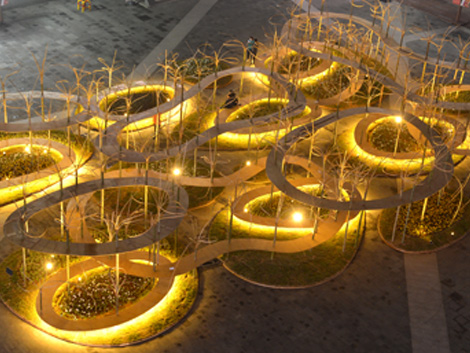DANCING IN A CIRCLE
This swirling art installation, created by one of Japan’s leading architects, offers a modern haven of contemplation and relaxation.
Designed by Japanese architect Toyo Ito, ‘Rinbu’ was created for the 2015 Gwangju Design Biennale in Korea. Made with 200 bamboo trees and horizontal floating slabs, the installation is situated in the Biennale Plaza.
Known for creating conceptual architecture, Toyo Ito is believed to be “one of the world’s most innovative and influential architects.” His art installation ‘Rinbu’ – the Japanese word for round dance, or, dancing in a circle - is an artificial bamboo forest, reinforced by birch and steel, that invites visitors to enter the open canopy and relax upon the seating positioned within its borders.
Spiraling in all directions, the bamboo ‘trees’ link together in random coils that create arcs designed to guide visitors into the forest. Between the bamboo poles, a series of slabs run at different levels to form benches, tables, and a roof that offers shade and protection from the elements. This configuration creates varying spaces that can be utilised by individuals or groups.
The apparently random placement of the bamboo poles reflects the architect’s practice of designing spaces where random columns are positioned to represent trees in a forest. This method creates comfortable architectural spaces that resemble the organic spaces in nature. Toyo Ito claims that modern cities are stacked homogenous grids, causing us to lose our primitive instincts in the artificial environment. ‘Rinbu’ represents a model of the ‘natural’ architecture he seeks to create.
Rinbu’s design is influenced by the landscape of Gwangju, which once served as a retreat for poets and artists hiding away from political pressure.
The lush forest landscape allowed them to commune with nature and gain inspiration as they strolled through the bamboo forests.
It is a sense of this 'haven of isolation and inspiration' that Toyo Ito wished to recreate with his installation. A space where visitors to Biennale could reflect upon their understanding of the works they were visiting and converse with each other as the artists of Gwangju
used to do in the bamboo forests.
CONTACT
Toyo Ito and Associates
Shibuya-ku, Tokyo
W www.toyo-ito.co.jp
PROJECT PARTICULARS
Client Gwangju Design Center
Location Gwanghu, Korea
Architects Toyo Ito and Associates
Construction Inc ARTEC/Hyowon Lee
Lighting EON SLD Co Ltd



